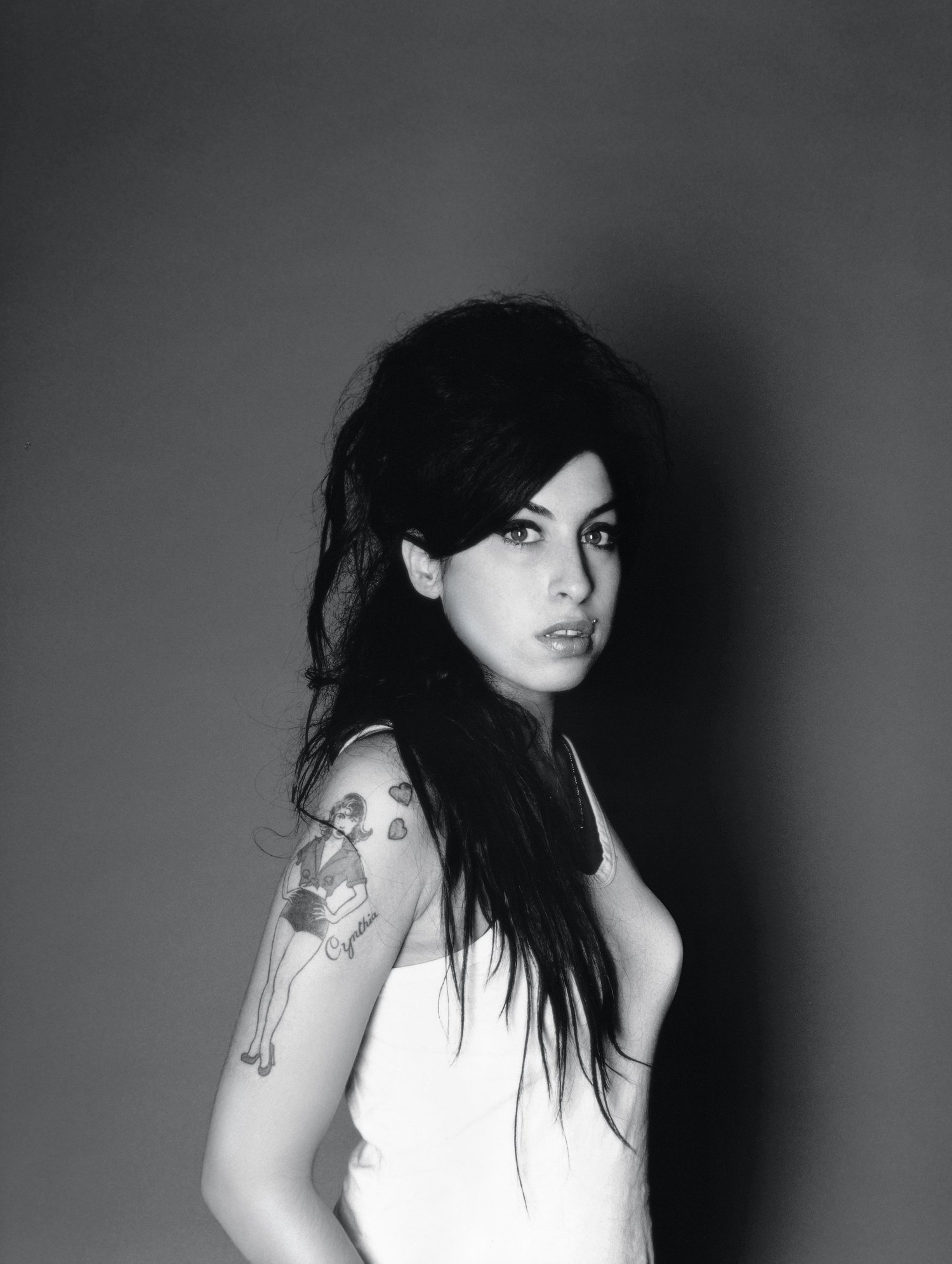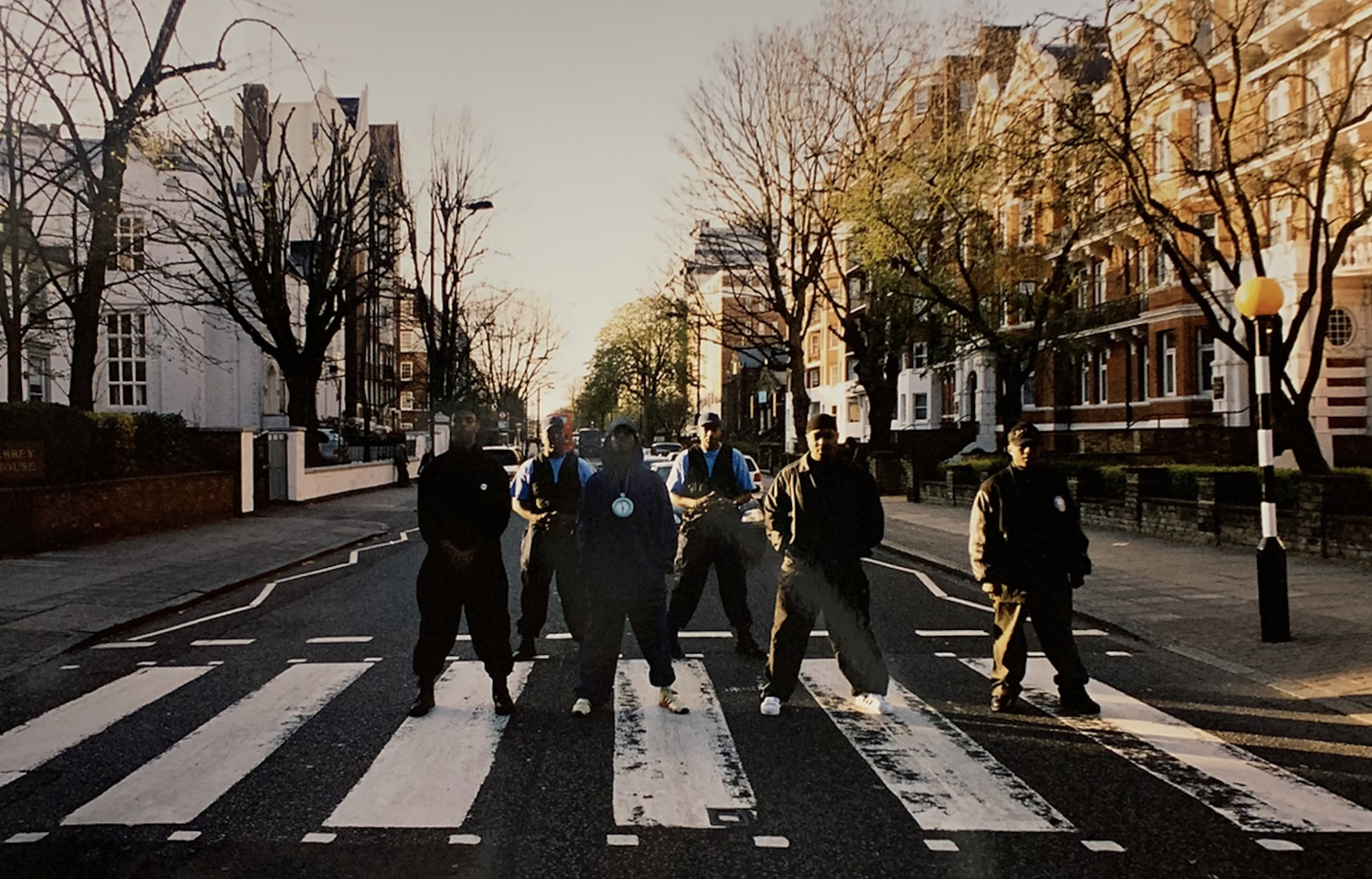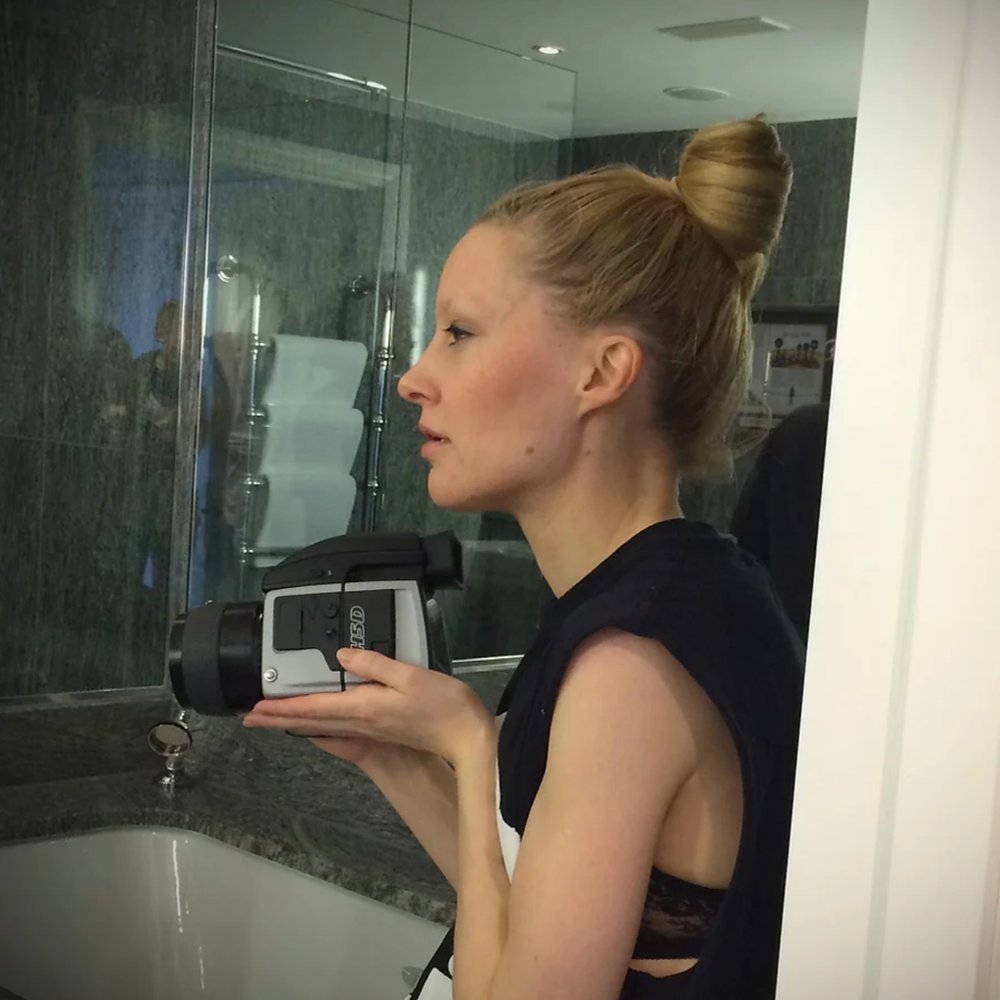Sarah J. Edwards: Finding Faces
N.E.R.D taken by Sarah J. Edwards for her magazine, BLAG. It was first published in BLAG Vol.2 Nø 10, 2008.
March 8th, 2022
For International Women’s Day 2022, we’re highlighting one of our favourite female photographers, Sarah J. Edwards. She’s one half of the identical twin founders of cultural icon BLAG magazine, which is currently celebrating its 30th year. Photographing the great and the good, from actors to musicians, her images have an intimacy that is often void from everyday celebrity photography. Sarah’s work places her at the heart of contemporary visual culture, often finding faces and subjects on the brink of superstardom and redefining a celebrity’s aesthetics with her lens.
Amy Winehouse taken by Sarah J. Edwards for her magazine, BLAG. It was first published in BLAG Vol.2 Nø 7, 2006.
POL: Hi Sarah! To start we’d love to get a bit about your background. Have you always been interested in photography?
SJE: I was captivated by pictures when I was really young, I would draw all the time. I got my first camera at six years old when my Dad traded petrol tokens for a moulded 35mm camera. During school, I managed to get into a week’s photography course when I was 12. That’s the only “formal’” education I received.
At around 14 I was spending most of my money on film and one hour photoshops. I used my Saturday job wages so I could keep a camera with me, and was self-taught from then on.
POL: When did you decide to pursue it as a career?
SJE: I was studying fashion at art college and just couldn’t get enough of the images I’d collect for research. I asked if I could add a photography component to my course - but, alas, they didn’t allow it.
My twin Sally and I started BLAG as a fanzine then. I took advantage of a cheap 35mm compact and one hour photo stores to take images for it. Shooting 90s bands as a teenager was more intimidating than I’d hoped!
To keep paying rent, I went on to model and then I became a publicist for musicians including Beastie Boys, Foo Fighters and Public Enemy. Here I was lucky enough to get a close up view of many big shoots and sometimes found myself assisting the photographers. I kept shooting, moving into SLR and then medium format.
In our spare time Sally and I were publishing our first few glossy editions of BLAG, and soon after were photographed for Placebo’s Without You I’m Nothing album sleeve by Corinne Day.
Black Eyed Peas taken by Sarah J. Edwards in London, 1998.
Public Enemy on Abbey Road, by Sarah J. Edwards, 2002.
“Shooting 90s bands as a teenager was more intimidating than I’d hoped!”
POL: That album went platinum, what was it like working on something so iconic?
SJE: I remember getting the call and thinking, two things, one: this is my chance to see how one of the greats works and two, maybe, maybe I can look as cool as Kate Moss.
The day was quite gruelling and nothing like we had anticipated. We shot in an eerie disbanded school outside of London. Corinne was extremely serious and had a team of very diligent assistants. We were worked flat out and it was very tiring. Not only was it a very tense set, I also remember being on my feet all day, hungry, thirsty and too hot. We were styled in layers of polyester school uniforms. It wasn’t until Sally fainted they understood we actually really needed to eat.
I took so much from that day: how specific Corinne was with her direction; the attention to detail. It was unlike the music shoots I’d done previously, where we were hurried due to bands schedules and had no time for formalities. That shoot was the catalyst for me wanting to be a photographer.
Around this time we got a book deal for BLAG and had our first coffee table edition published a year later, I managed to get dozens of 35mm shoots together and was really proud of the work.
POL: Other than Corrine Day, who else inspires your photography?
SJE: I took inspiration from my fashion studies and the face-to-face inspiration over the years. Aside from that I always loved film. I find it fascinating how specific angles and subtle shots can be used to present characters strengths and weakness, emphasising what the actors bring. It could be a twinkle in the eye, but these tiny things can move us all.
OutKast taken by Sarah J. Edwards for her magazine, BLAG. It was first published in BLAG Vol.2 Nø 6, 2006
Broken Bells taken by Sarah J. Edwards for her magazine, BLAG. It was first published in BLAG Vol.3 Nø 2, 2010
“I always loved film. I find it fascinating how specific angles and subtle shots can be used to present characters strengths and weakness.”
POL: Your bio says your “portraits are firmly rooted in capturing natural emotion and are influenced by her love of iconic film” - what is it that drew you to cinema?
SJE: I was captured by scenes from Raging Bull, the lighting, slow motion and score to really draw you into the characters emotions. Also, Coppola’s Rumble Fish, Jarmusch’s Down By Law - just so much style.
I’ve found much inspiration in the work of Martin Scorsese, Francis Ford Coppola and Jim Jarmusch. From Wes Anderson to Alfred Hitchcock and David Fincher, they all have very specific styles, but the one thing they have in common is tonnes of character.
POL: Can you talk a little about your philosophy around portrait photography?
SJE: I’m interested in humans: how we take on board compliments and criticism; how we sift through the mass of information presented to us on a daily basis to form our beliefs; what tools we take to support ourselves. Hardly any of us of us have enough time or peace to truly choose anymore. I think offering and giving people time and space is really powerful and one of the most respectful and generous things we can do for each other.
I like to empower my subjects with down-to-earth conversations, good music and fun sets. We’re all in it together and I don’t believe in hierarchy as such, just a respect for life. I think everyone deserves to enjoy the gift of life and I love to capture people genuinely relaxed and at ease - in their true essence.
POL: What is it like on your set? How does a shoot normally go?
SJE: Fun! As much as many of my photographs can look perhaps serious, I like to create a friendly atmosphere. I love to chat with my subjects ahead of taking any pictures. Healthy food, drinks and great background music are also really helpful.
I love the perfect crossroads of humour and professionalism. I understand how nerve racking being the subject can be.
Lupe Fiasco taken by Sarah J. Edwards in London, 2005.
Franz Ferdinand taken by Sarah J. Edwards for her magazine, BLAG. It was first published in BLAG Vol. 3 Nø 1, 2009
Anthony Rossomando taken by Sarah J. Edwards for her magazine, BLAG. It was first published in BLAG Vol.2 Nø 7, 2006.
“I’m interested in humans, how we take on board compliments and criticism, how we sift through the mass of information presented to us on a daily basis to form our beliefs.”
POL: Can you define your “ethics” as a photographer ?
SJE: First of all, I think it’s important everyone is treated with respect on a shoot. Everyone there has built or is growing a skill set, and they had enough drive and ambition to be there with their own specialty. I like to chat a little with everyone involved, from the sitter through to anyone tending to the studio/space. This way we create a bond and everyone realises they are all appreciated for why they are there and what they’re bringing to the table.
The goal is to dismantle any potential nervousness and ego, bring out ease with down-to-earth conversation and good humour. I love images to be natural and relaxed, so the atmosphere in the room/location should reflect that.
I’ve been on the other side of the camera, sometimes feeling like an object, not really knowing why I’m there and with little clue about the intentions of the desired outcome. Feeling part of a project is really key for everyone.
I love to visualise finished results before I even hold up the camera. I think everyone has magic in them and I think I’m in a really fortunate position to work with people who’ve discovered that within themselves and they’re focused on making their dreams come true. Documenting that for everyone is a lovely feeling. I also believe images can evoke awe and if can ever do that, I’d be delighted.
POL: How did you find your approach?
SJE: I found my approach while I was working in music PR and at the same time making BLAG in my spare time.
I was in the unusual position to be on both sides of the fence: spending time with often anxious artists ahead of big photo shoots; alongside watching editorial teams pushing their ideas of how images should be, vs musicians who rarely think about themselves in the same terms. I got to see collaborations unfold, people finding common ground and yet not compromise creativity.
“The goal is to dismantle any potential nervousness and ego, bring out ease with down-to-earth conversation and good humour.”
Questlove taken by Sarah J. Edwards for her magazine, BLAG. Photographed on location in Soho, London, 2005
Fenton Bailey taken by Sarah J. Edwards for her magazine, BLAG. On location in Surrey, England, it was first published in BLAG Vol.2 Nø 7, 2006.
POL: How do you get that kind of collaboration on your set?
SJE: Well, when I first started shooting musicians and bands, there was an expectation that photos would happen instantly and pretty naturally. The idea of photoshoots taking hours wouldn’t cross anyones minds. I think artists like The Ramones set a president, they all knew themselves enough to look the way they wanted lined up against a wall.
I think some artists felt it was that simple, but really I’m sure a whole lot of self-talk was involved.
We would ask to book a band in for a few hours and it would be seen as a kind of “out there” request. 15 minute shoots were standard. Which wasn’t enough time for walk around the outside of a venue, or time to grab a meal at a diner to get pics.
We always wanted to create art, make timeless and iconic images, and bring in fashion. I think it’s important to understand there’s a process to achieving images. We had planned shots, but with time with bands we could capture beautiful ad hoc documentary photos. Images which are born from other kinds of moments that are cultivated by deep thought, or creativity, with subjects being in their element.
POL: Has the photography industry changed since you began shooting?
SJE: I often found myself being one of the only women working on a press day and would be greeted with all kinds of joking comments. Afterwards I often heard “these are pretty good actually” - it was the “actually” that emphasised the disbelief of my capabilities.
I think now women are treated with somewhat more respect. However, little things still happen, and they feel louder. I popped into a camera shop before Christmas last year and I felt like I’d stepped foot in a motor garage.
I’m so grateful the conversations are rapidly changing and that respect is being recognised as essential. Hopefully it will filter into all aspects of the industry.
Lucie Jelfs taken by Sarah J. Edwards for her magazine, BLAG. On location in Covent Garden, London, it was first published in BLAG Vol.2 Nø 3, 2005
Lucie Jelfs taken by Sarah J. Edwards for her magazine, BLAG. On location in Covent Garden, London, it was first published in BLAG Vol.2 Nø 3, 2005
Lucie Jelfs taken by Sarah J. Edwards for her magazine, BLAG. On location in Covent Garden, London, it was first published in BLAG Vol.2 Nø 3, 2005
“I’ve been on the other side of the camera, sometimes feeling like an object, not really knowing why I’m there or little clue about the intentions of the desired outcome.”
POL: Have you noticed a change in how sitters are in shoots compared to when they started - do they want to take more control over their image?
SJE: Absolutely, I think everyone is aware of the currency of an iconic image. I do think social media has in a roundabout way created more entitlement and people are in their own heads maybe a little too much. I think without careful use of social media people can inherit an unnatural sense of ego. It’s like, we’re finally starting to get the conversation right, and now let’s address the self-talk, and at the same time get rid of that imposter syndrome.
A lot of my sitters who have big career goals are very cautious of image and want to see everything before going to print. I think where a movie or video doesn’t give this opportunity, they feel a shoot can.
The one thing I’d say is, we, as photographers and image makers, have been doing this a long time and are also always looking forward - keeping involved in the conversations that are happening in a socially conscious way. So trusting the process with experienced people is a nice opportunity.
POL: Do you think there is room for creativity and new ideas in the age on the internet and social media?
SJE: Yes, I think there have been some blueprints to a successful career. Let’s look at Hollywood, a successful movie is made from existing IP, which did all the ground work and got the fan base. A piece of original IP is rarely getting a green light. Everyone wants to be the next Adele or Ryan Reynolds. Everyone needs a hybrid: “oh, they have the sensibilities of X, the look of Y and the voice of Z”.
I don’t know, I’m at the point where I want to learn about an artist who desires to make a great impression on the world. What contrast are they working from? What was that critical moment that spurred them to say “this is me now”?
OutKast taken by Sarah J. Edwards for her magazine, BLAG. It was first published in BLAG Vol.2 Nø 6, 2006
Jay Maud taken by Sarah J. Edwards for her magazine, BLAG. On location in Surrey, England, it was first published in BLAG Vol.2 Nø 7, 2006
POL: What do you think the status of photography is today?
SJE: I think we’re at a turning point with images. This is a wonderful and very important moment where people are acknowledging the artistry of photography. I love that photography collectors are becoming recognised. This feels on par with the moment many street artists began to be taken seriously and collected around 2007.
There’s a vast network of professionals involved in photography, from the incredible design of new equipment to the labs keeping up with the times and offering us services for film and digital work.
On a micro level no one photo is the same, so there’s now a bigger dialogue about how special photography is.
POL: Where do you want see the photography industry going in the next five/ten years?
SJE: Technology is allowing better printing, so I definitely hope to see more photography exhibitions.
LA and New York have been celebrating photographers as artists for decades. There is so much talent in the world, I’d love to see more meaningful and large scale shows here in London.
I think technology can also allow photographers to create more content on-the-spot and in one go.
“This is a wonderful and very important moment where people are acknowledging the artistry of photography.”
Sarah J. Edwards during her photoshoot with Noomi Rapace at Ham Yard Hotel, London. Spring 2015.
About Sarah J. Edwards
Sarah J. Edwards’ intimate portraits are firmly rooted in capturing natural emotion and are influenced by her love of iconic film.
She empowers her subjects using inspiration of the silver screen’s greatest protagonists and using her own eclectic life experience. She directs them to express subtle emotion by using fictional scenarios to arouse thought.
“I’m interested in humans, how we take on board compliments or criticism and how we sift through the mass of information presented to us on a daily basis to form our beliefs. What tools we take to support ourselves.”
She draws inspiration from the work of directors from Martin Scorsee, Francis Ford Coppola and Jim Jarmusch, Wes Anderson to Alfred Hitchcock and David Fincher.
In 1992, while at Art School, Sarah along with her twin sister Sally A. Edwards founded a fanzine called BLAG. Realising it a rewarding outlet for their love of music, film, fashion and culture, the duo grew it to become an independent glossy distributed all around the world.
This allowed Sarah to establish her photography style and shoot many of the worlds most recognisable musicians and actors in many stages of their careers.
Her subjects have included: Aaron Taylor Johnson, Adrien Brody, Amy Winehouse, Beastie Boys, Ciara, James McAvoy, OutKast, Queens of the Stone Age, Slash, Rinko Kikuchi, Noomi Rapace, Helen McCrory and John Legend.
Sarah has also photographed for Rolling Stone, Dazed, The Guardian and Beastie Boys.
















